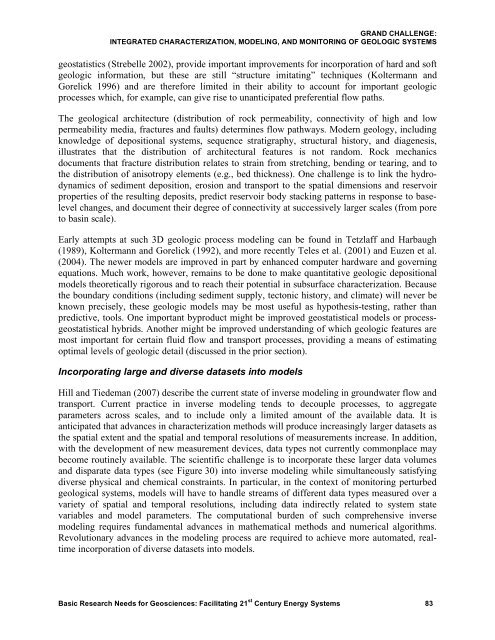Basic Research Needs for Geosciences - Energetics Meetings and ...
Basic Research Needs for Geosciences - Energetics Meetings and ...
Basic Research Needs for Geosciences - Energetics Meetings and ...
- No tags were found...
You also want an ePaper? Increase the reach of your titles
YUMPU automatically turns print PDFs into web optimized ePapers that Google loves.
GRAND CHALLENGE:INTEGRATED CHARACTERIZATION, MODELING, AND MONITORING OF GEOLOGIC SYSTEMSgeostatistics (Strebelle 2002), provide important improvements <strong>for</strong> incorporation of hard <strong>and</strong> softgeologic in<strong>for</strong>mation, but these are still “structure imitating” techniques (Koltermann <strong>and</strong>Gorelick 1996) <strong>and</strong> are there<strong>for</strong>e limited in their ability to account <strong>for</strong> important geologicprocesses which, <strong>for</strong> example, can give rise to unanticipated preferential flow paths.The geological architecture (distribution of rock permeability, connectivity of high <strong>and</strong> lowpermeability media, fractures <strong>and</strong> faults) determines flow pathways. Modern geology, includingknowledge of depositional systems, sequence stratigraphy, structural history, <strong>and</strong> diagenesis,illustrates that the distribution of architectural features is not r<strong>and</strong>om. Rock mechanicsdocuments that fracture distribution relates to strain from stretching, bending or tearing, <strong>and</strong> tothe distribution of anisotropy elements (e.g., bed thickness). One challenge is to link the hydrodynamicsof sediment deposition, erosion <strong>and</strong> transport to the spatial dimensions <strong>and</strong> reservoirproperties of the resulting deposits, predict reservoir body stacking patterns in response to baselevelchanges, <strong>and</strong> document their degree of connectivity at successively larger scales (from poreto basin scale).Early attempts at such 3D geologic process modeling can be found in Tetzlaff <strong>and</strong> Harbaugh(1989), Koltermann <strong>and</strong> Gorelick (1992), <strong>and</strong> more recently Teles et al. (2001) <strong>and</strong> Euzen et al.(2004). The newer models are improved in part by enhanced computer hardware <strong>and</strong> governingequations. Much work, however, remains to be done to make quantitative geologic depositionalmodels theoretically rigorous <strong>and</strong> to reach their potential in subsurface characterization. Becausethe boundary conditions (including sediment supply, tectonic history, <strong>and</strong> climate) will never beknown precisely, these geologic models may be most useful as hypothesis-testing, rather thanpredictive, tools. One important byproduct might be improved geostatistical models or processgeostatisticalhybrids. Another might be improved underst<strong>and</strong>ing of which geologic features aremost important <strong>for</strong> certain fluid flow <strong>and</strong> transport processes, providing a means of estimatingoptimal levels of geologic detail (discussed in the prior section).Incorporating large <strong>and</strong> diverse datasets into modelsHill <strong>and</strong> Tiedeman (2007) describe the current state of inverse modeling in groundwater flow <strong>and</strong>transport. Current practice in inverse modeling tends to decouple processes, to aggregateparameters across scales, <strong>and</strong> to include only a limited amount of the available data. It isanticipated that advances in characterization methods will produce increasingly larger datasets asthe spatial extent <strong>and</strong> the spatial <strong>and</strong> temporal resolutions of measurements increase. In addition,with the development of new measurement devices, data types not currently commonplace maybecome routinely available. The scientific challenge is to incorporate these larger data volumes<strong>and</strong> disparate data types (see Figure 30) into inverse modeling while simultaneously satisfyingdiverse physical <strong>and</strong> chemical constraints. In particular, in the context of monitoring perturbedgeological systems, models will have to h<strong>and</strong>le streams of different data types measured over avariety of spatial <strong>and</strong> temporal resolutions, including data indirectly related to system statevariables <strong>and</strong> model parameters. The computational burden of such comprehensive inversemodeling requires fundamental advances in mathematical methods <strong>and</strong> numerical algorithms.Revolutionary advances in the modeling process are required to achieve more automated, realtimeincorporation of diverse datasets into models.<strong>Basic</strong> <strong>Research</strong> <strong>Needs</strong> <strong>for</strong> <strong>Geosciences</strong>: Facilitating 21 st Century Energy Systems 83
















